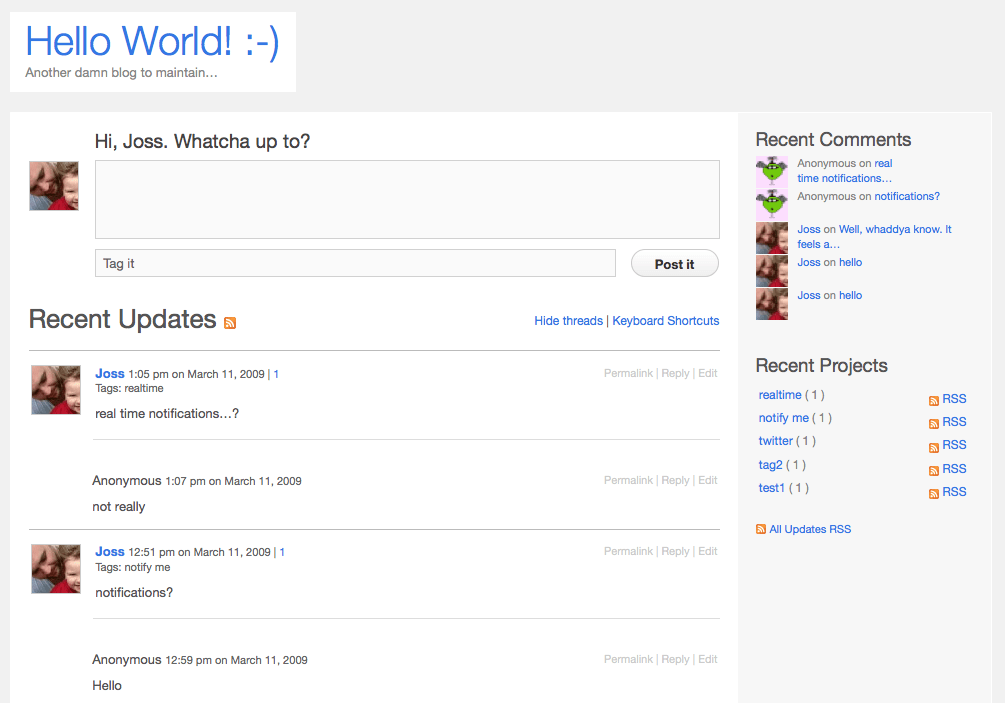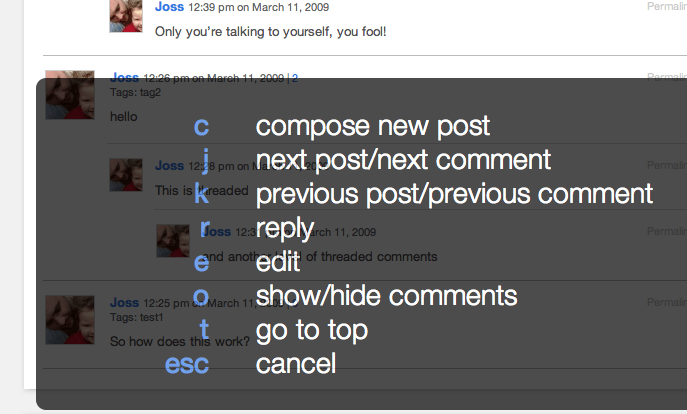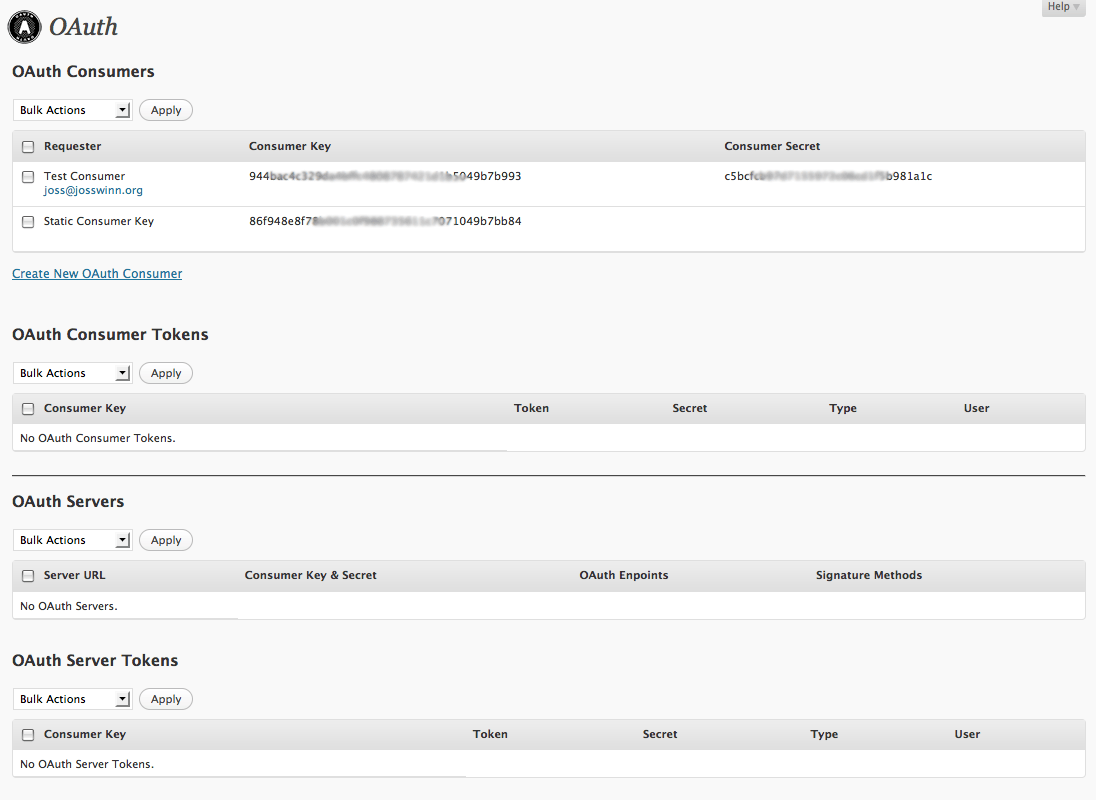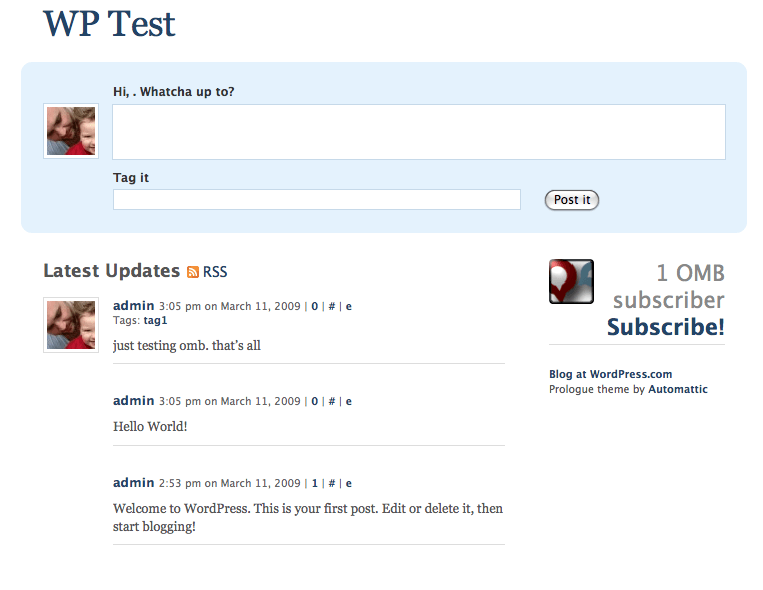Automattic, the company behind WordPress, released an update to Prologue, their theme for group discussion, today. I read about this, minutes after reading about the new OAuth features in WordPress 2.8 and an hour or so after reading about a new Facebook Connect plugin for BuddyPress, the social networking layer for WordPress. All this stimulation proved a bit too much for me, so this post is an attempt to plot what’s happening here and what might be possible in just a few months from now…
So, I have the BuddyPress Facebook Connect plugin working on a my test installation…

Nothing fancy going on there. Basically, new users to the site can register using their Facebook credentials. The plugin doesn’t do anything for existing users on the site. They just login with their local account as usual. For a first release, the plugin is a good proof of concept and with a bit more integration work will make it easy for Facebook users to join BuddyPress sites.
The new Prologue theme, P2, is impressive, too…

It takes advantage of the new threaded comments feature in WordPress 2.7+ , has ‘realtime’ notifications (unless I’ve missed something, the use of the term ‘realtime’ is a stretch – see below) and has some nice keyboard shortcuts…

One thing that’s lacking is a Twitter-like realtime notification that a new post has been made and you should refresh your bowser. Twitter doesn’t use it for the user home page, but they do on their search page and I like it.

Moving on, OAuth functionality for WordPress is still in development but the latest code from the SVN trunks of both the DiSo plugin and WordPress does appear to work…

Be warned that it does not run on a server where PHP runs as a CGI. I tried to run it first on Dreamhost, but it gave an error showing that getallheaders() is an undefined function.
I need to spend more time with the OAuth plugin to see how it will actually work in practice. One of the first use-cases for it is to allow client applications like the iPhone app, to be able to post remotely without sending a password using XML-RPC. If anyone has any ideas and wants to test it with me, please leave a comment. As I understand from the announcement, it’s working but it’s still early days… For more information, see Will Norris’ presentation from last August.
Finally, there’s mnw, a new plugin for WordPress that provides support for the OpenMicroBlogging specification. With this, users from other sites using the specification, such as identi.ca and other Laconica-based services, can subscribe to your blog/omb site and receive updates whenever you publish a new post or page. So this…
 …ends up here…
…ends up here…

mnw is still a bit rough around the edges but it was only released as V0.1 a month ago, so that’s to be expected. Note that mnw only seems to work on single WP installations (WPMU produces a familiar error message which I think is wp_nonce related) and does not work on WP 2.8 trunk. Also, identi.ca complained of my avatar image being the wrong size. In the example above, I’d removed my avatar from the mnw settings, but I’ve since found that a .png of 96px seems to work OK.
What does it mean for me and you?
So, what does all this mean? In terms of wordpress.com, we might speculate that before too long, they will add the BuddyPress layer to their 4.5m blogs to create a sizeable social network. The P2 theme shows posts in realtime, they’re already offering an XMPP firehose of blog posts and there are plugins that offer XMPP functionality for WordPress, so remote real-time updates aren’t far away and realtime remote publishing already exist using XML-RPC. With the P2 theme, anyone can create a Twitter-like site that any number of registered users can post to and anyone can comment on. Add OpenID authentication and OAuth authorisation and you’ve got a large, mature and open social (micro)blogging service.
For self-hosted WordPress users, it’s even closer to being a reality. I’ve had a site running today that accepts new user registrations via the DiSo OpenID plugin and those users can then post updates to the Prologue themed site and join a threaded group discussion. If I enabled XML-RPC posting, users could post in ‘realtime’ to the group site from their iPhone or other other client app. With OAuth support, this would be possible from desktop and mobile applications as well as other sites such as Flickr, without exchanging protected user data such as a password. Those updates could also be broadcast via XMPP in realtime, which I’ve done on another blog I was testing.

Things are a bit different for WordPressMU/BuddyPress installations. As you’ve seen above, I’ve got a BuddyPress site running that accepts users joining via Facebook connect. Functionality is limited to social networking and it still has some issues that need working on before it’s ready for every-day use (I’ve noted them on the BP forum). WPMU blogs (by which I mean blogs not the overall site) don’t allow new-user registrations so the blog adminstrator needs to sign up new users. Users registered via Facebook don’t have an email address associated with their account, so blog admins can’t add these types of users as the process requires a username and email address of a new or existing user.
However, by activating the right plugins, registered WPMU users (I’m thinking university staff and students) could participate in a group microblog using the P2 theme, LDAP and/or OpenID for login and XML-RPC and XMPP for remote publishing and receiving posts. It won’t be too long before you can send and receive WordPress posts via your GMail or Jabber account (on your iPhone/iPod) in realtime (hopefully with support for tagging), and all of that data is simply WordPress data and has RSS feeds hanging off every tag and wrapped around every post.
Just a thought.









